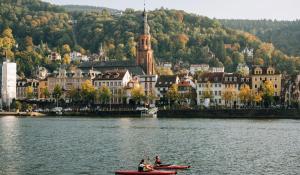
The economy can thrive without harming the environment or the beings that call our planet home. This is at the heart of Green America’s mission and why we work for a green economy. Yet that vision seems hard to reach when good jobs and workers’ rights are pitted against the environment—a narrative that doesn’t have to be true.
Historically, industry has exploited both workers and the environment through poor working conditions and pollution. Yet history also shows that people stand up to right these wrongs—whether that be enacting child labor laws, the Clean Water Act, or unionizing workforces.
Recently, some companies have adopted more just and green policies, helping to lead industry towards better standards, such as the minority-owned SUNS (Solar Uptown Now Services) Cooperative that employs people of color in steady, clean-energy jobs. While state-wide policies are failing the green economy movement, such as Texas’ mandate for fossil fuels over renewables, there is hope in the Inflation Reduction Act and the small businesses leading the charge.
It’s more important than ever that worker-organizers, unions, and organizations like Green America are working collectively towards a future where people don’t have to choose between a good job and a clean environment.
Blue Fenceline Communities
Blue collar workers are among the first people to face the impacts of environmental issues. Many live in fenceline communities—neighborhoods that are near high-polluting warehouse districts, industrial factories, and dumps.
In the north of Birmingham, Alabama, the Bluestone Coke plant (which makes fuel for steel manufacturing) has been polluting historically Black neighborhoods for decades. The EPA has designated it as “the 35th Ave Superfund site.” Arsenic and lead have been found in residential soil due to leaks from the plant, and residents bear the burden of disproportionately high rates of respiratory issues and cancer.
For generations, residents have worked at the coke plant without knowledge of the harm it caused to their health and their communities. As blue-collar factory workers, this circumstance demonstrates the tragic intersection of environmental injustice and workers.
Jean Tong, Green America’s labor campaigns director, says that this issue spans industries, from the 35th Avenue Superfund to southeast Los Angeles, where garment workers make clothes that contain harmful chemicals for low pay.
“Low-wage workers who face poor working conditions on the job are often living in highly polluted fenceline communities,” says Tong. “Low-income working families are also vulnerable consumers to products sold by companies such as Amazon or Shein that may contain toxic chemicals because of their low prices.”
Tong calls these compounded stressors the “triple-whammy”on low-wage workers—unsafe working conditions, high exposure to environmental risks, and limited access to affordable and healthy essential daily products and food. They are the reasons why organizing at the intersection of workers’ rights and environmental justice is so important.
Where Blue Collar Meets Green
With environmental issues affecting blue collar workers acutely, shouldn’t labor groups and environmental organizations to work together? It’s not that simple.
For example, Native American communities led the fight against the Keystone XL Pipeline, joined by environmentalists and other concerned citizens. When President Biden canceled the pipeline, it was celebrated as a win among these allies. However, the Laborers’ International Union of the North and more labor unions supported the Keystone XL for its creation of steady union jobs. Today, these same unions applaud Biden’s approval of the long-delayed Willow Project in Alaska, which once again is being fought by local Native American communities and allied environmentalists. While these fossil fuel projects contribute to the climate crisis, they also provide steady good-paying jobs for union workers.
“It’s not fair or practical to ask workers to choose between feeding their families and saving the environment,” says Tong. “The responsibility falls on a comprehensive national ‘just transition’ plan toward green jobs and renewable energy. They are two sides of the same coin.”
BlueGreen Alliance, an organization which unites labor unions and environmental organizations for the shared interest of a clean environment and quality jobs, seeks to create policy solutions to these issues.
“We don’t want folks to have to choose between a good job and a clean environment,” Katie Harris, BlueGreen Alliance’s legislative director, says. “We advocated for the Inflation Reduction Act [IRA]. For the first time, labor standards are attached to clean energy tax credits.” This will incentivize companies to invest in clean energy resources that pay a prevailing wage for the tax credits they will earn—prevailing wage means a basic hourly rate given to people who work the same job, used by the government to ensure that tax credits or dollars only go to businesses that pay workers fairly.
This means that under 2022’s IRA, investments in clean energy must also consider the wellbeing of the workers—a major step forward for energy justice. More than nine million clean energy jobs could be created over the next decade with these rules in mind.
Community in Clean Energy
Responsibility falls on corporations to switch to clean energy and support good jobs. Corporations are responsible for 75% of all energy used in the US, according to the American Council for an Energy-Efficient Economy.
Telecom companies are expected to grow in influence as society becomes more dependent on telecoms to communicate and conduct business, according to Green America’s “Calling for a Just, Clean Transition” 2021 report. They have power to influence clean energy investments with their massive energy use and advance energy justice in the workforce by employing underserved communities.
Dan Howells, Green America’s climate campaigns director, says that public pressure is needed to get companies to transition to clean energy. Whether that’s publicly on social media or calling your provider directly, it’s important for the public to take part.
“The inevitable is coming,” says Howells. “We’ve already reached peak-oil, -coal, and the fossil fuel industry is in decline. The next step is, who’s going to build, install, and maintain all new renewable energy infrastructure and systems?”
Howells uses the example of electric charging stations. As electric vehicles grow in popularity, charging stations are built to serve the same function as gas stations—refueling. However, as more stations pop up across the nation, a workforce will have to maintain them. Our report urges companies to employ women and people of color, to protect workers by honoring the right to organize, and offer prevailing wages.
ChargerHelp! in Los Angeles is a company growing this workforce. ChargerHelp! offers electric vehicle supply equipment technician training and certification, re-skilling for workers looking to change fields, and trainings for workforce development organizations.
As companies like ChargerHelp! transition the workforce into an emerging energy landscape, Howells emphasizes how important conversation between communities and companies is to workers.
“It starts with a conversation: companies with market power should consult with communities where they have current or future projects,” says Howells. “And, they should make sure that the good jobs that come along with renewable energy projects benefit those communities.”
Under the IRA, corporations are eligible for clean energy tax credits, which incentivizes them to invest in good jobs for clean-energy workers.
An Energy Transition for Everyone
Historically, low-income communities and communities of color have been the last to see the benefits of energy transitions and the first to experience negative effects—the neighborhoods near the 35th Avenue Superfund site are a prime example of many environmental injustices around the country. But Green America’s telecoms and labor justice campaigns as well as organizations like BlueGreen Alliance are working to make sure history won’t repeat itself in the clean energy transition.
“In the times we’ve had big economic shifts, there are people who’ve been left behind,” says Harris. “There has to be intentional investments in keeping communities whole. We can make sure that the communities that want these investments actually have a say.”
Harris references coal miners in Appalachia that support the transition to clean energy jobs. United Mineworkers Association members urged Sen. Joe Manchin (D-WV) to support Biden’s 2022 budget bill for its policies of employing former miners in new industries. With the passing of the IRA later that year, there is $369 billion allocated for the transition to renewable energy, some of which will be spent to bolster a clean energy economy in West Virginia.
“Labor union apprenticeship programs have the power to uplift immigrants and communities of color by providing a pathway toward middle class jobs and access to crucial benefits like affordable health care and pensions,” says Tong.
The US can reach for the new frontier of clean energy without leaving anyone behind by addressing the triple win of a just transition: supporting workers’ needs and rights; safeguarding the environment and tackling climate change; and addressing the communities affected. With these tools, labor unions and environmental groups can work towards a future where good jobs and a healthy environment go hand in hand.







